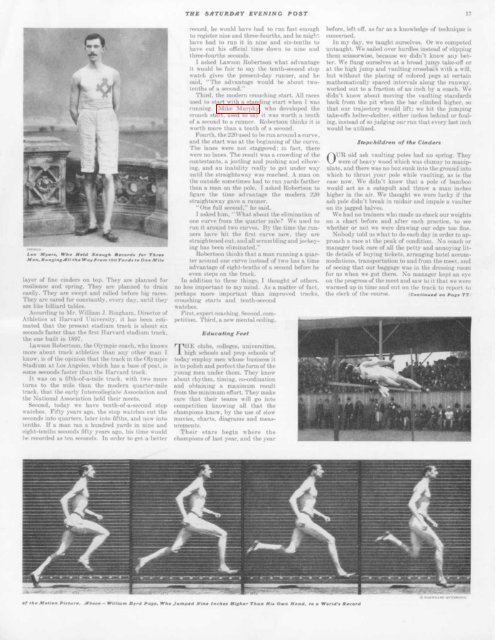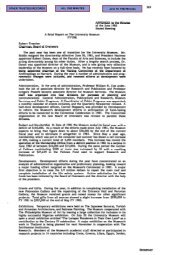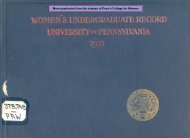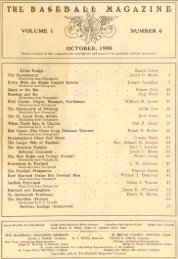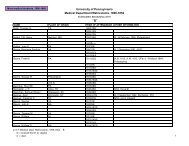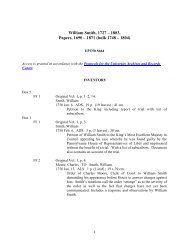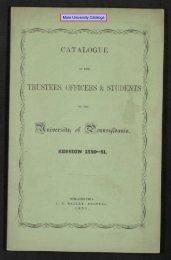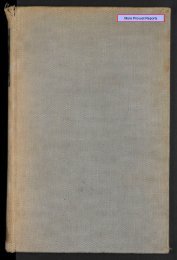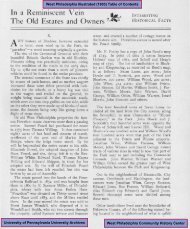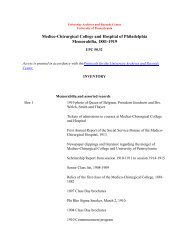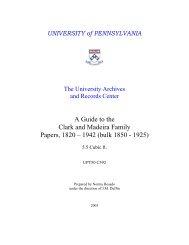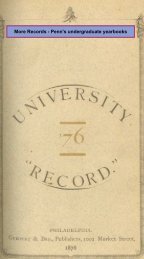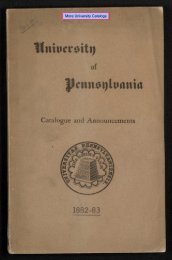Percy C. Madeira - University Archives and Records Center ...
Percy C. Madeira - University Archives and Records Center ...
Percy C. Madeira - University Archives and Records Center ...
You also want an ePaper? Increase the reach of your titles
YUMPU automatically turns print PDFs into web optimized ePapers that Google loves.
Lon Myers . Who HeId Enough <strong>Records</strong> for Three<br />
Men . Ranging, All the Way From 100 Yards to One Mil e<br />
layer of fine cinders on top . They are planned fo r<br />
resilience <strong>and</strong> spring . They are planned to drai n<br />
easily . They are swept <strong>and</strong> rolled before big races .<br />
They are cared for constantly, every day, until the y<br />
are like billiard tables .<br />
According to Mr . William J. Bingham, Director of<br />
Athletics at Harvard <strong>University</strong> . it has been estimated<br />
that the present stadium track is about si x<br />
seconds faster than the first Harvard stadium track ,<br />
the one built in I897 .<br />
Lawson Robertson, the Olympic coach, who know s<br />
more about track athletics than any other man I<br />
know, is of the opinion that the track in the Olympi c<br />
Stadium at Los Angeles, which has a base of peat, is<br />
some seconds faster than the Harvard track .<br />
It was on a fifth-of-a-mile track, with two mor e<br />
turns to the mile than the modern quarter-mil e<br />
track, that the early Intercollegiate Association an d<br />
the National Association held their meets .<br />
Second, today we have tenth-of-a-second sto p<br />
watches. Fifty years ago, the stop watches cut the<br />
seconds into quarters, later into fifths, <strong>and</strong> now int o<br />
tenths. If a man ran a hundred yards in nine an d<br />
eight-tenths seconds fifty years ago, his time would<br />
be recorded as ten seconds . In order to get a better<br />
THE SATURDAY EVENING POS T<br />
record, he would have had to run fast enoug h<br />
to register nine <strong>and</strong> three-fourths . <strong>and</strong> h e might<br />
have had to run it in nine <strong>and</strong> six-tenths t o<br />
have cut his official time down to nine an d<br />
three-fourths seconds .<br />
I asked Lawson Robertson what advantage<br />
it would be fair to say the tenth-second sto p<br />
watch gives the present-day runner, <strong>and</strong> h e<br />
said, "The advantage would be about twotenths<br />
of a second . "<br />
Third, the modern crouching start . All race s<br />
used to start with a st<strong>and</strong>ing start when I wa s<br />
running . Mike Murphy . who developed th e<br />
crouch start. used to say it was worth a tent h<br />
of a second to a runner . Robertson thinks it i s<br />
worth more than a tenth of a second .<br />
Fourth . the 220 used to be run around a curve ,<br />
<strong>and</strong> the start was at the beginning of the curve .<br />
The lanes were not staggered : in fact, there<br />
were no lanes . The result was a crowding of th e<br />
contestants, a jostling <strong>and</strong> pushing <strong>and</strong> elbowing,<br />
<strong>and</strong> an inability r eally to get under way<br />
until the straightaway was reached . A man on<br />
the outside sometimes had to run yards farther<br />
than a man on the pole . I asked Robertson to<br />
figure the time advantage the modern 220<br />
straightaway gave a runner .<br />
"One full second ." he said .<br />
I asked him . " What about the elimination of<br />
one curve from the quarter mile? We used t o<br />
run it around two curves . By the time the runners<br />
have hit the first curve now, they ar e<br />
straightened out, <strong>and</strong> all scrambling <strong>and</strong> jockey -<br />
ing has been eliminated . "<br />
Robertson thinks that a man running a quarter<br />
around one curve instead of two has a time<br />
advantage of eight-tenths of a second before he<br />
even steps on the track .<br />
In addition to these things . I thought of others .<br />
no less important to my mind . As a matter of fact .<br />
perhaps more important than improved tracks ,<br />
crouching starts <strong>and</strong> tenth-secon d<br />
watches .<br />
First, expert coaching . Serond, com -<br />
competition . Third, a new mental ceiling .<br />
Educating Feet<br />
HE clubs, colleges, universities,<br />
Thigh schools <strong>and</strong> prep schools of<br />
today employ men whose business i t<br />
is to polish <strong>and</strong> perfect the form of th e<br />
young men under them . They kno w<br />
about rhythm, timing, co-ordinatio n<br />
<strong>and</strong> obtaining a maximum r esul t<br />
from the minimum effort . They mak e<br />
sure that their teams will go into<br />
competition knowing all that the<br />
champions know, by the use of slo w<br />
movies, charts, diagrams <strong>and</strong> measurements<br />
.<br />
Their stars begin where th e<br />
champions of last year. <strong>and</strong> the year<br />
of the Motion Picture . Above— William Byrd Page Who jumped Nine Inches Higher Than His Own Head . to a World's Record<br />
1 7<br />
before, left off. as far as a knowledge of technique i s<br />
concerned .<br />
In my day . we taught ourselves . Or we comp e ted<br />
untaught . We sailed over hurdles instead of clipping<br />
them scissorwise, because we didn't know any bet -<br />
ter. We flung ourselves at a broad jump take-off o r<br />
at the high jump <strong>and</strong> vaulting crossbars with a will .<br />
but without the placing of colored pegs at certai n<br />
mathematically spaced intervals along the runway .<br />
worked out to a fraction of an inch by a coach . W e<br />
didn ' t know about moving the vaulting st<strong>and</strong>ards<br />
back from the pit when the bar climbed higher, so<br />
that our trajectory would lift : we hit the jumping<br />
take-offs helter-skelter, either inches behind or foul -<br />
ing, instead of so judging our run that every last inc h<br />
would he utilized .<br />
Stepchildren of the Cinders<br />
UR old ash vaulting poles had no spring . The y<br />
O were of heavy wood which was clumsy to manipulate<br />
. <strong>and</strong> there was no box sunk into the ground into<br />
which to thrust your pole while vaulting, as is th e<br />
case now . We didn 't know that a pole of bamboo<br />
would act as a catapult <strong>and</strong> throw a man inche s<br />
higher in the air . We thought we were lucky if the<br />
ash pole didn't break in midair <strong>and</strong> impale a vaulte r<br />
on its jagged halves .<br />
We had no trainers who made us check our weight s<br />
on a chart before <strong>and</strong> after each practice, to see<br />
whether or not we were drawing our edge too fine .<br />
Nobody told us what to do each day in order to approach<br />
a race at the peak of condition. No coach o r<br />
manager took care of all the petty <strong>and</strong> annoying little<br />
details of buying tickets, arranging hotel accommodations<br />
. transportation to <strong>and</strong> from the meet . an d<br />
of seeing that our baggage was in the dressing roo m<br />
for us when we got there. No manager kept an ey e<br />
on the progress of the meet <strong>and</strong> saw to it that we we r e<br />
warmed up in time <strong>and</strong> out on the track to r eport t o<br />
the clerk of the course . (Continued on Pa te 7 7


